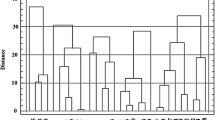Abstract
The response of linseed somatic tissue to in vitro cultivation can be improved if the gene action involved is known. Nine homozygous lines, seven F1 and fifty F2 plants were cultivated in MS basal medium with 0.1 mg/l BAP. Callogenesis and regeneration analyses were done using a random model in order to separate environmental and genotypic effects at 10, 20 and 30 days after culture initiation. Genetic variability for callogenesis and regeneration was observed, that could be used in a breeding program. The appropriate period for the evaluation of callogenesis was at 20 days after culture initiation. For regeneration, this moment would depend on the selection criterion adopted. To select genotypes on the basis of earliness in shooting at 10 days would be preferable, while for ability of producing shoots, 30days would be more suitable. For both characters the analyses of genetic action indicated that, non-additive effects were involved in the culture response, however the expression of callogenesis and regeneration ability had different genetic basis.
Similar content being viewed by others
References
Cointry, E.L., L.A. Mroginsky & L.A. Picardi, 1992. Heterosis intervarietal e interespecífica para la capacidad de regeneración in vitro en el género Linum. Mendeliana 10: 97–105
Cointry, E.L., L.A. Mroginsky & L.A. Picardi, 1993. Incidencia de la concentración de reguladores de vegetales sobre la formación de vástagos in vitro en tres explantos de lino (Linum usitatissimum L.) Agriscientia 10: 39–43.
Deaton, W.R., S.G. Metz, T.A. Armstrong & P.N. Mascia, 1987. Genetic analysis of the anther-culture response of three spring wheat crosses. Theor Appl Genet 74: 334–338.
Elena, E.B. & H.D. Ginzo, 1988. Effect of auxin levels on shoots formation with different embryo tissue from a cultivar and a commercial hybrid of wheat Triticum aestivum L. J Plant Physiol 132: 600–603.
Falconer, D.S. & T.F.C. Mackay, 1996. Introduction to Quantitative Genetics, pp. 464. 4th ed. Logman Group Ltd.
Gamborg, O.L. & J.P. Shyluk, 1976. Tissue culture, protoplasts and morphogenesis in flax. Bot Gaz 137: 301–306.
Gomez Da Cunha, A.C. & M.F. Ferreira, 1996. Somatic embryogenesis, organogenesis and callus growth kinetics of flax. Plant Cell Tissue and Org Cult 47: 1–8.
Griffing, B., 1956 Concept of general and specific combining ability in relation to dialell crossing systems. Aust J Biol Sci 9: 463–493.
Hallauer, A.R. & J.B. Miranda, 1982. Quantitative genetics in maize breeding, pp. 468. 2nd ed. Iowa State University Press, Ames.
Hayman, B.I., 1954. The theory and analysis of dialell crosses. Genetics 39: 789–809.
Lane, D.W., 1979. Influence of growth regulators on root and shoot initiation from flax meristem-tips and hypocotyls in vitro. Physiol Plant 45: 260–264.
Lazar, M.D., P.S. Baenziger & G.W. Schaeffer, 1984. Combining abilities and heritability of callus formation and plantlet regeneration in wheat (Triticum aestivum L. anther cultures. Theor Appl Genet 68: 131–134.
Ling, H.Q. & H. Binding, 1987. Plant regeneration from protoplasts in Linum. Plant Breed 98: 312–317.
Mariotti, J.A., 1986. Fundamentos de genética biométrica. Aplicaciones al mejoramiento vegetal. Secretaría General de la OEA. Programa Nacional de Desarrollo Científico y Tecnológico. Serie de Biología. Monografía n° 32, pp. 152.
Murashige, T. & F. Skoog, 1962. A revised medium for rapid growth and bioassays with tobacco tissue cultures. Physiol 15: 473–497.
Murray, B.E., Handyside, R.J. & W.A. Keller, 1977. In vitro regeneration of shoots on stem explants of haploid and diploid flax (Linum usitatissimum L.). Can J Genet Cytol 19: 177–186.
Nichterlein, K., H. Umbach & W. Friedt, 1991. Genotypic and exogenous factors affecting shoot regeneration from anther callus of linssed (Linum usitatissimum L.). Euphytica 58: 157–164.
Roca, W.M. & L.A. Mroginsky, 1991. Cultivo de tejidos en la agricultura. Fundamentos y aplicaciones, pp. 970. CIAT, Cali, Colombia.
SAS, Institute Inc., 1989. SAS/STAT TM. User's Guide, Version 6, Fourth Edition, Volume 2, Cary, NC: SAS Institute. Inc., pp. 846.
Sugimoto, K. & Y. Takeoka, 1998. Genetic analysis of plant regeneration ability in anther culture of rice (Oryza sativa L.). Breed Sci 48: 115–121.
Tejklovà, E., 1992. In vitro morphogenesis in flax (Linum usitatissimum L.). 1992. XIII Th Eucarpia Congress. Angers, France.
Author information
Authors and Affiliations
Rights and permissions
About this article
Cite this article
Bonell, M.L., Lassaga, S.L. Genetic analysis of the response of linseed (Linum usitatissimum L.) somatic tissue to in vitro cultivation. Euphytica 125, 367–372 (2002). https://doi.org/10.1023/A:1016013609068
Issue Date:
DOI: https://doi.org/10.1023/A:1016013609068




